41 The benefits of sex
The evolution of sexual reproduction presents a paradox: despite its significant costs, such as the two-fold cost of males, it remains the dominant mode of reproduction for many organisms. This chapter explores the evolutionary benefits of sex, focusing on two key concepts: the Red Queen hypothesis, which suggests that sex allows species to adapt continuously in an ever-changing environment, particularly in the arms race against parasites and pathogens, and Muller's ratchet, which highlights how sexual reproduction helps prevent the accumulation of harmful mutations in populations. Together, these theories provide insight into why sex persists despite its apparent disadvantages.
Lecture Video: Benefits of Sex
The Red Queen hypothesis
What does Lewis Carroll’s Red Queen have to do with sex?
-
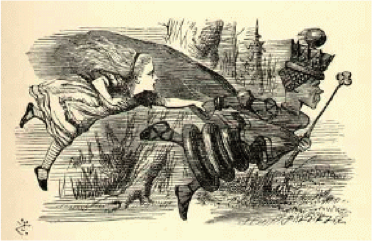
Figure 1: "Through the Looking Glass" by John Tenniel Public Domain, https://commons.wikimedia.org/w/index.php?curid=2040219
In this scene from Through the Looking-Glass and What Alice Found There by Lewis Carroll, Alice and the Queen run with all their effort – yet make no progress. Such is the claim that sex allows organisms to avoid extinction by keeping up in a very odd sort of race.
Alice never could quite make it out, in thinking it over afterwards, how it was that they began: all she remembers is that they were running hand in hand, and the Queen went so fast that it was all she could do to keep up with her: and still the Queen kept crying “Faster! Faster!”, but Alice felt she could not go faster, though she had not breath left to say so.
The most curious part of the thing was, that the trees and the other things round them never changed their places at all: however fast they went, they never changed their places at all: however fast they went they never seemed to pass anything. “I wonder if all the things move along with us?” thought poor puzzled Alice. And the Queen seemed to guess her thoughts, for she cried “Faster! Don’t try to talk!”
Not that Alice had any idea of doing that. She felt as if she would never be able to talk again, she was getting so much out of breath: and still the Queen cried “Faster! Faster!”, and dragged her along. “Are we nearly there?” Alice managed to pant out at last.
“Nearly there!” the Queen repeated. “Why, we passed it ten minutes ago! Faster!” And they ran on for a time in silence, with the wind whistling in Alice’s ears, and almost blowing her hair off her head, she fancied
“Now! Now!” cried the Queen. “Faster! Faster!” And they went so fast that at last they seemed to skim through the air, hardly touching the ground with their feet, till suddenly, just as Alice was getting quite exhausted, they stopped, and she found herself sitting on the ground, breathless and giddy.
The Queen propped her up against a tree, and said kindly, “You may rest a little, now.”
Alice looked round her in great surprise. “Why, I do believe we’ve been under this tree the whole time! Everything’s just as it was!”
“Of course it is, “ said the Queen. “What would you have it?”
“Well, in our country, “ said Alice, still panting a little, “you’d generally get to somewhere else – if you ran very fast for a long time as we’ve been doing.”
“A slow sort of country!” said the Queen. “Now here, you see, it takes all the running you can do, to keep in the same place. If you want to get somewhere else, you must run at least twice as fast as that!”
“I’d rather not try, please!” said Alice….
Through the Looking-Glass and What Alice Found There by Lewis Carroll
Is sex part of an arms race?
In one human generation, HIV (the virus that causes AIDS) will reproduce over a million times. Given how natural selection works—via heritable variation and differential reproduction—human beings don’t stand a chance against this virus. How can we possibly adapt to such a fast-moving target? For that matter, how can any longer-lived organism compete with a quickly reproducing and quickly evolving enemy? Many of these enemies, or pathogens, such as viruses and bacteria, are also numerous and difficult to detect—invisible to the naked eye, they can enter a host’s body silently and reproduce with a fervor while their victims remain blissfully unaware. Given these challenges, how can any host organism defend itself against its would-be attackers? According to one hypothesis, outwitting pathogens is the whole point of sex.
The Red Queen
We are in the midst of an evolutionary arms race, in which host and parasitic pathogen must constantly adapt. Parasites must adapt to the host’s natural defenses, and host populations are under pressure to keep up with their ever-changing parasites. This reciprocal evolution between two types of organisms (in this case, host and parasite) is a type of coevolution. According to the Red Queen Hypothesis, sex exists as a mechanism for keeping up with rapidly coevolving pathogens. By generating genetic diversity, sex makes host organisms a moving target. Like Alice and the Red Queen in Lewis Carroll’s novel (Box 3), both host and parasite are running a race in which neither makes any observable progress. Yet, if the host organisms didn’t change dramatically with each new generation (if they didn’t have sex), they might go extinct.
Parasites adapt to exploit the most common type of host. Therefore, a host that can produce offspring that have novel defenses against parasites would have an advantage over an organism producing clones--simply by making offspring that are different.
Testing the Red Queen Hypothesis
The Red Queen hypothesis—that sex evolved to combat our coevolving pathogens—can be tested by analyzing a few key predictions of this hypothesis:
- Sex is most beneficial where there is a high risk of infection
- Pathogens are more likely to attack common phenotypes (for example, clones) in a population, as opposed to the less-common counterparts (such as those that resulted from sex)
- In sexually reproducing populations, individuals choose mates that maximize diversity in their offspring
Note that all of these predictions implicitly rely on the heritability of being healthy (in this case, the ability to combat pathogens); specifically, parents must be able to pass along to their offspring genes for avoiding pathogens. Testing these predictions has resulted in several lines of evidence supporting the Red Queen hypothesis.
Prediction 1: Sex is most beneficial where there is a high risk of infection
An excellent system for testing this prediction involves a flatworm parasite in the genus Microphallus, a duck, and a small mud snail (Potamopyrgus antipodarum; Figure 7.6). This species of snail is able to reproduce sexually or asexually. The extent of sexual reproduction in a population of snails can be quantified by counting the number of males—asexual snails are all female.
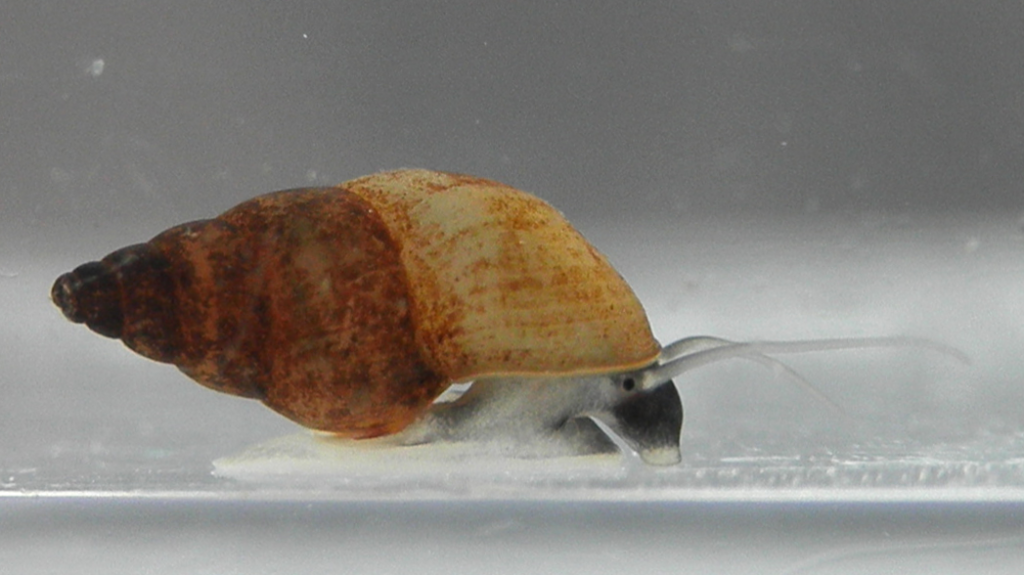
The flatworm’s life cycle begins inside of the snail, where the worm emerges from its egg. Infected snails are consumed by ducks. Once in the duck’s intestine, adult worms have sex and produce eggs. Flatworm eggs are released, with duck feces, into the water, where they are ingested by snails and the cycle continues (Figure 2). Snails are harmed by this flatworm, largely because a symptom of infection is sterilization (the flatworm’s scientific name, Microphallus, translates to “small penis”).
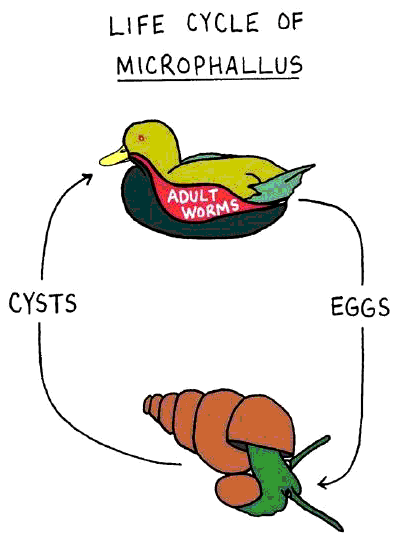
Observations of this system in two New Zealand lakes (Alexandrina and Kaniere) revealed that snails are more likely to be sexual (measured by frequency of males) in shallow waters, where ducks feed, than in deeper waters, where ducks do not feed (Figure 3).
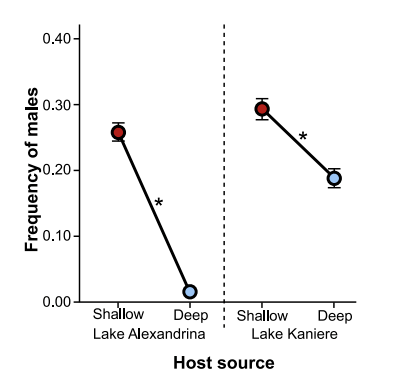
These results suggest that coevolutionary pressure is greater on the snails in the shallows, presumably because the feeding ducks effectively “close the circle” on the worm’s life cycle. Finally, higher infection rates in the shallows indicate that, in support of Prediction 1, above, sex is most beneficial where there is a high risk of infection.
Prediction 2: Pathogens are more likely to attack common phenotypes in a population, as opposed to the less-common counterparts
In the Mexican desert there are isolated pools inhabited by a species of minnow. Within these pools, populations of asexually reproducing individuals exist alongside sexually reproducing individuals. Fish in these ponds exhibit “black spot disease,” which is caused by a parasitic flatworm. Investigators have observed the frequency of sexual and asexual fish and the number of black spots in each type of fish in these ponds. Clonal fish are likely to have the most common phenotype in these ponds (as they are genetically identical to each other), while the sexually reproducing fish will have a wide variety of infrequent phenotypes. As the Red Queen predicts, the common type of fish (usually one of the clonal species) had the highest number of parasitic spots. In ponds where there was a genetically diverse, sexually reproducing population, the sexual fish had fewer spots.

Additional evidence comes from the evening primrose (Figure 4), a flowering plant that--like the minnows, snails, and water fleas discussed above--exists in sexual and asexual forms. Evening primrose can be damaged by mildew from a pathogenic fungus. The plants produce an enzyme protein called chitinase to defend themselves against this fungus. A recent comparison indicated that the sexually reproducing primrose plants had greater variety in the gene that codes for chitinase than did the asexual plants. In addition, the overall amount of chitinase expressed was higher in the sexual plants than in the asexuals. Finally, the researchers found that the plants that were more resistant to mildew damage had higher fitness (they produced more fruit, and thus more offspring) in the presence of that pathogen. In evening primrose, greater diversity in a key gene renders an individual less susceptible to a pathogen, supporting the prediction that parasites are more likely to attack the most common phenotype in a population, and providing additional evidence for The Red Queen.
Know Your Pathogens
A pathogen is something that infects and causes a fitness cost in another organism. Pathogens come in a wide variety; some of them are not even considered living!
Prions – Prions are non-living infectious agents that are misfolded proteins.
Viruses – Whether you consider viruses alive or not depends on your definition of life. Viruses are protein-encased DNA or RNA entities that hijack a cell’s replication machinery to reproduce. Viral infections include influenza, HIV, HPV, and herpes.
Fungal pathogens – Fungi are responsible for a variety of infections including mildew, thrush, athlete’s foot and smut.
Bacteria – Bacteria are prokaryotic organisms that occur everywhere. There are more bacteria in and on you than there are cells in your body. Fortunately, the vast majority of bacteria are benign. However, some bacteria cause problems such as urinary-tract infections, some kinds of pneumonia, ear infections, pertussis (whooping cough), chlamydia, gonorrhea, and syphilis.
Protists – Protists are single-celled eukaryotes that cause diseases such as malaria and amoebic dysentery.
Animals –Common animal pathogens include lice, many types of worms, and parasitic wasps.
Prediction 3: In sexually reproducing populations, individuals choose mates that maximize diversity in their offspring
If there is a fitness advantage to diversity, parents can best maximize their offspring’s potential (and have more grand-offspring) with careful mate choice. There are numerous examples of organisms preferring mates that increase offspring diversity, and shunning mates that might do the opposite. Even many hermaphrodites, with both male and female sex organs, seek other hermaphrodites for copulation...even if they are capable of self-fertilization.
An excellent model for studying mate choice is Atlantic Salmon, an important commercial fish that lives its life in the ocean and returns to freshwaters to mate (or spawn). Sofia Consuegra and Carlos Garcia de Leaniz compared offspring diversity of salmon that were mated in a commercial fish hatchery (and unable to choose their mates) against that of salmon allowed to choose mates in the wild. The hatchery-spawned fish exhibited lower diversity than did the wild-spawned fish. Furthermore, hatchery-spawned fish displayed a greater number of roundworm parasites (Anisakis) then did their wild-spawned counterparts (Figure 5). These results support the prediction that individuals will choose mates that maximize diversity in their offspring. Also, this work adds fuel to The Red Queen hypothesis by illustrating a potential benefit to Atlantic Salmon--namely, parasite avoidance.
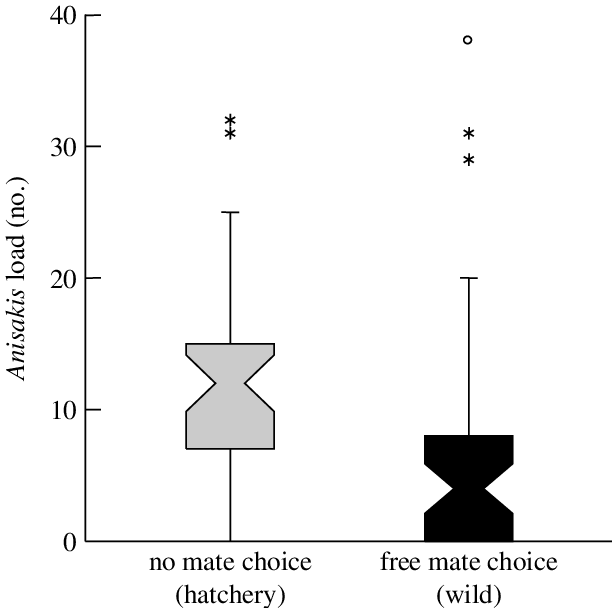
Muller's ratchet
Mutations are a fact of life. All organisms possess DNA that is different from the DNA they inherited, and this altered DNA, or mutation, is the ultimate source of all genetic variation. Some have suggested that one of the benefits of sex is its ability to rid the body of harmful (or deleterious) mutations.
Sex and DNA repair
Mutations arise from random errors in DNA replication: by the insertion or deletion of mobile genetic elements, or through the effects of various mutagens (e.g., chemical compounds or radiation) that damage DNA. However, most of the damage that occurs to a cell’s DNA is repaired. The cell has numerous tools that it can use to fix the damage that can occur.
Mutagens such as radiation can cause single- and double-strand breaks in the double helix of DNA. If there is damage to only one DNA strand, the other strand can be used as a template for repair. More problematic is when both strands of DNA break; when this happens there is not a simple way to re-synthesize the lost DNA. In cells that are diploid (cells that have two copies of each chromosome), there is a complementary chromosome, or homologue, available--but in order to be useful, it must be close to the damaged DNA.
Chromosome pairs are close together in the first stage of meiosis, in which crossing over between the chromosomes occurs. In fact, many of the cellular tools used to repair double strand breaks in DNA are the same ones that facilitate crossing over (homologous recombination) during meiosis. So, if meiosis repairs damaged DNA, and meiosis is essential to sexual reproduction, perhaps sex exists because of the repair benefits of meiosis itself.
Sex and Ratchets
A ratchet works because it rotates in one direction, but not the other. Similarly, once a mutation occurs within a population, it is extremely unlikely to un-occur. Because mutations are relatively rare and occur randomly in an organism’s genome, there is very low probability that there will be a “back mutation” or a second mutation in the exact same spot to undo the first mutation. Thus, over time, a lineage will likely accumulate increasing numbers of mutations, some of them harmful. This idea is often called “Muller’s ratchet,” after Hermann Joseph Muller, who hypothesized it, and the simple machine, the ratchet (Figure 6).

According to Muller’s ratchet hypothesis for the existence of sex, sexual reproduction is better able to eliminate harmful mutations from the genome. Creating a variety of gametes and combining those gametes with another individual (who would presumably have a different collection of mutations) results in some of the offspring carrying more harmful mutations than others. Presumably, the individuals or gametes with fewer harmful mutations survive and reproduce more successfully. In this way, through sex, a lineage has an opportunity to shuffle its genetic material, and produce some offspring with fewer harmful mutations (and the most beneficial ones). Thus, the shuffling of material that occurs during sexual reproduction essentially rotates the ratchet backwards.
Evidence supporting Muller’s ratchet
A testable prediction associated with Muller’s ratchet is: Mutations accumulate more rapidly in asexually reproducing organisms than in sexual organisms. To investigate this hypothesis, scientists study organisms that occur in both sexual and asexual forms. One such animal is the microscopic water flea (Daphnia; Figure 7), which can be maintained in clonal or sexual lineages.

A comparison of strains of water fleas that reproduce asexually with those that occasionally have sex revealed that the asexual strains have more mutations. Specifically, the asexual water fleas have a higher proportion of substitution mutations that result in amino acid changes. This comparison supports the hypothesis that sexual reproduction reduces the accumulation of potentially harmful (or deleterious) mutations. Similar observations have been made in sexual and asexual lineages of freshwater snails.
Lecture Video: Review of the Evolution of Sex
Glossary
Red Queen Hypothesis
sex exists as a mechanism for keeping up with rapidly coevolving pathogens
Muller's Ratchet
Muller's ratchet explains that sexual reproduction is better able to eliminate harmful mutations from the genome as opposed to asexual reproduction
This chapter is licensed under a Creative Commons Attribution-NonCommercial-ShareAlike 4.0 International License

